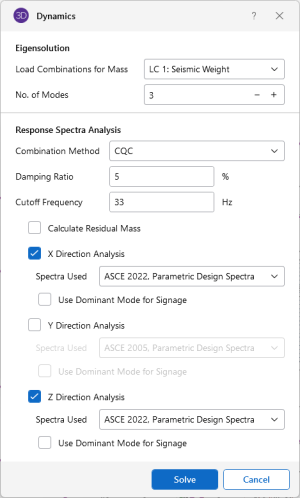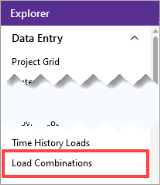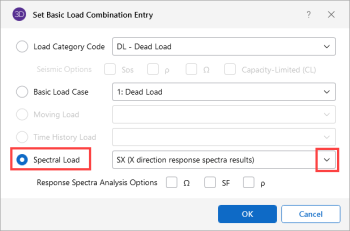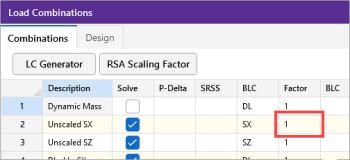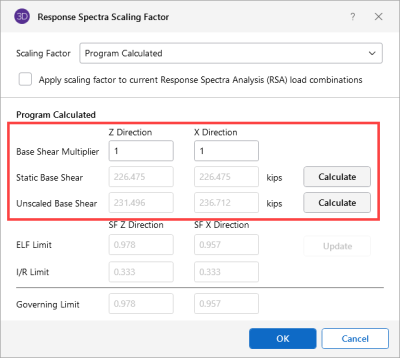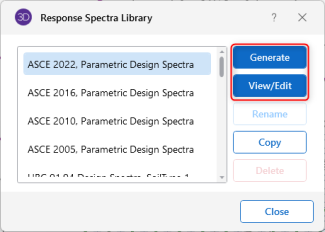Dynamic Analysis - Response Spectra
A Response Spectra Analysis can be performed after the dynamic analysis to obtain forces, stresses and deflections. In general, the response spectra analysis procedure is based on the assumption that the dynamic response of a structural model can be approximated as a summation of the responses of the independent dynamic modes of the model.
Response Spectra Analysis Procedure
To run a Response Spectra analysis:
-
Go to the Home ribbon.
Click on image to enlarge it
-
Click the Solve icon down-arrow.
Click on image to enlarge it
-
Choose Dynamics from the solution options that appears, to open the Dynamics window.
Click on image to enlarge it
- Click the Load Combinations for Mass down-arrow and choose the LC you want.
- Set the No. of Modes using the “-” or “+’” to increase or decrease the number.
- Use the Response Spectra Analysis checkboxes to indicate which directions you want to perform the analysis.
- Choose the spectra to be used for each direction.
- Type the Damping Ratio percentage.
- Type the Cutoff Frequency (in Hz).
-
Click Solve to run the analysis.
Note:- For a more thorough explanation of the Eigensolution options refer to Dynamic Analysis - Eigensolution.
- Upon the completion of the solution you are returned to the Frequencies spreadsheet and the participation yielded by the RSA is listed. To view model results such as forces/deflections/reactions you will need to create a load combination on the Load Combination spreadsheet that includes the spectra results. See below.
- The Dynamic Solver options are located in the Model Settings - Solution tab Advanced options.
Include Response Spectra Analysis Results in Load Combination
To in the Response Spectra analysis results in a Load Combination:
-
Go to the Explorer panel Data Entry section.
Click on image to enlarge it
-
Click on Load Combinations.
The Load Combinations spreadsheet opens.
Click on image to enlarge it
-
Click the BLC ellipsis button.
A Set Basic Load Combination Entry window opens.
Click on image to enlarge it
-
Choose Spectral Load and then click the down-arrow.
-
Choose "SX","SY", or "SZ" as the BLC entry.
-
SX for the X direction RSA results
-
SY for the Y direction RSA results
-
SZ for the Z direction RSA results
-
-
(Optional) To scale the spectral results, click in the Factor column of the row and type the spectra-scaling factor, as shown in the following image.
Click on image to enlarge it
Note:You can include more than one spectra solution in a single load combination (as shown in the following image). If you do this, you can also have RISA-3D combine the multiple RSA results using an SRSS summation. To use the SRSS summation, set the RSA SRSS flag for the combination to "+" or “-”.
-
Use “+” if you want the summed RSA results (which will be all positive) added to the other loads in the load combination.
-
Use “-” if you want the summed results subtracted.
Click on image to enlarge it
-
Response Spectra
The response spectra represent the maximum response of any single degree of freedom (SDOF) system to a dynamic base excitation. The usual application of this method is in seismic (earthquake) analysis. Earthquake time history data is converted into a "response spectrum". With this response spectrum, it is possible to predict the maximum response for any SDOF system. By "any SDOF system", it is meant a SDOF system with any natural frequency. "Maximum response" means the maximum deflections, and thus, the maximum stresses for the system.
Response Spectra Analysis Procedure
In the response spectra analysis procedure, each of the model's modes is considered to be an independent SDOF system. The maximum responses for each mode are calculated independently. These modal responses are then combined to obtain the model's overall response to the applied spectra.
The response spectra method enjoys wide acceptance as an accurate method for predicting the response of any structural model to any arbitrary base excitation, particularly earthquakes. Building codes require a dynamics based procedure for some structures. The response spectra method satisfies this dynamics requirement. The response spectra method is easier, faster and more accurate than the static procedure so there really isn't any reason to use the static procedure.
If you wish to learn more about this method, an excellent reference is Structural Dynamics, Theory and Computation by Dr. Mario Paz (1991, Van Nostrand Reinhold).
Frequencies Outside the Spectra
If a response spectra analysis is solved using modal frequency values that fall outside the range of the selected spectra, RISA extrapolates to obtain spectral values for the out-of-bounds frequency. If the modal frequency is below the smallest defined spectral frequency, a spectral velocity is used for the modal frequency that results in a constant Spectra Displacement from the smallest defined spectral frequency value. A constant spectral displacement is used because modes in the “low” frequency range tends to converge to the maximum ground displacement. If the modal frequency is above the largest defined spectral frequency, a spectral velocity is used for the modal frequency that results in a constant Spectra Acceleration from the largest defined spectral frequency value. A constant spectral acceleration is used because modes in the “high” frequency range tend to converge to the maximum ground acceleration (zero period acceleration).
Mass Participation
Click on image to enlarge it
The mass participation factors reported on the Frequencies spreadsheet reflect how much each mode participated in the Response Spectra Analysis solution. Remember that the RSA involves calculating separately the response for each mode to the applied base excitation represented by the spectra. Here is where you can tell which modes are important in which directions. Higher participation factors indicate more important modes. The participation factor itself is the percent of the model's total dynamic mass that is deflecting in the shape described by the particular mode. Thus, the sum of all the participation factors in a given direction can not exceed 100%.
The amount of participation for the mode may also reflect how much the mode moves in the direction of the spectra application. For example, if the 1st mode represents movement in the global Y direction it won't participate much, if at all, if the spectra is applied in the global X direction. You can isolate which modes are important in which directions by examining the mass participation.
- Usually for the RSA to be considered valid, the sum of the modal participation factors must equal or exceed 100% (e.g. ASCE7-22, Section 12.9.1.4.1). If you do an RSA and the total participation is less than 100%, you need to return to the dynamic solution and redo the dynamic analysis with more modes. If you are getting a lot of modes with little or no participation see Dynamics Troubleshooting – Local Modes.
- You may also want to account for accidental torsion. See Modeling Accidental Torsion to learn how to do this.
- Models with a large amount of mass lost into boundary conditions may have difficulty achieving 100% mass participation. See Dynamics Modeling for more information.
Modal Combination Option
There are three choices for combining your modal results: CQC, SRSS or Gupta. In general, you’ll want to use either CQC or Gupta.
-
CQC stands for "Complete Quadratic Combination".
Use CQC for models where you don’t expect much rigid response.
-
Use Gupta for models where the rigid response could be important.
An example of one type of model where rigid response would be important is the analysis of shear wall structures.
-
Use the SRSS method in case you need to compare results with the results from some older program that does not offer CQC or Gupta.
CQC stands for "Complete Quadratic Combination". A complete discussion of this method will not be offered here, but if you are interested, a good reference on this method is Recommended Lateral Force Requirements and Commentary, 1999, published by SEAOC (Structural Engineers Assoc. of Calif.). In general, the CQC is a superior combination method because it accounts for modal coupling quite well.
The Gupta method is similar to the CQC method in that it also accounts for closely spaced modes. In addition, this method also accounts for modal response that has “rigid content”. For structures with rigid elements, the modal responses can have both rigid and periodic content. The rigid content from all modes is summed algebraically and then combined via an SRSS combination with the periodic part which is combined with the CQC method. The Gupta method is fully documented in the reference, Response Spectrum Method, by Ajaya Kumar Gupta (Published by CRC Press, Inc., 1992).
The Gupta method defines lower ( f 1 ) and upper ( f 2 ) frequency bounds for modes containing both periodic and rigid content. Modes that are below the lower bound are assumed to be 100% periodic. Modes that are above the upper bound are assumed to be 100% rigid.
Unsigned (All Positive) Results and the Use Dominant Mode For Signage Checkbox
A response spectra analysis involves calculating forces and displacements for each mode individually and then combining these results. The problem is both combination methods offered (SRSS and CQC) use a summation of squares approach that loses the sign. This means that all the results are positive, except reactions, which are all negative as a result of the positive displacements.
Because the RSA results are unsigned you cannot directly add the results to other static loads in you model. One way around this is to treat the RSA results as both positive and negative by manually providing the sign. Using two combinations for each RSA result, one with a positive factor and the other with a negative factor you can capture the maximum deflections, stresses and forces when combining with other loads. See Load Combinations with RSA Results for an example.
The mass participation may indicate that a model is dominated by a single mode in a direction. You can base the signs for the final combined RSA results on the signs for the RSA for this single dominant mode, by checking the box that says “Use Dominant Mode for Signage?”. When selected, the Mode that has the highest mass participation in that direction is considered to be the dominant mode.
Limitations on Response Spectra Results
Because of the statistical method used to combine the results , response spectra results can be confusing or misleading to engineers that are not familiar with the process. The confusion is usually associated with the fact any single response spectra result is correct, but that it is not known whether the sign of that result should be positive or negative. This results in a number of limitations that should be considered when using response spectra analysis.
Limitations on Response Spectra Results
|
Limitation |
Description |
|---|---|
|
By default with an RSA solution the results will not obey statics, due to the nature of combining the modes via SRSS, CQC, etc. Thus, if you view the reactions, member forces, etc., the model will not obey statics. If the model has a "dominant" mode in the given direction then the normal path forward would be to select the Use Dominant Mode for Signage? checkbox when solving for the dynamic solution. For additional advice on this topic, please see the RISA Tips & Tricks webpage at risa.com/post/support. Type in Search keywords: Response Spectra Reactions Satisfy Statics. |
|
|
Deflected Shape |
By default with an RSA solution the results will not obey statics, due to the nature of combining the modes via SRSS, CQC, etc. Thus, if you view the deflected shape you will see that the deflected shape looks odd. Similar to the "Statics" limitation above, one possible path forward is to use the Use Dominant Mode for Signage? checkbox when solving your dynamic solution. For additional advice on this topic, please see the RISA Tips & Tricks webpage at risa.com/post/support. Type in Search keywords: Response Spectra Reactions Satisfy Statics. |
|
Plate and Wall Contours |
Plate contours are not presented to the user for RSA load combination unless the Use Dominant Mode for Signage? option has been chosen. This is because the results can be misleading due to the "Statics" issue described above. |
|
Wall Panel Reactions |
Wall Panel reactions consist of a number of internal nodal reactions that are then summed together across the wall. Since the signs of those reactions are unknown, the reactions for each Wall Panel cannot be correctly calculated. There are two methods of dealing with this issue:
Note: The Wall Force results (in the detail reports and the Wall Force Results spreadsheet) are calculated correctly because each force is calculated and stored for each mode, which allows a final RSA result to be calculated using the combination method (SRSS, CQC etc) chosen by you. A future revision to the program may be to calculate and store wall reactions for each mode similar to what is done for the Wall Forces spreadsheet.
|
|
Internal Force Summation Tools |
Because the Internal force summation tool relies on plate corner forces, these results are not available for wall panels for any load combination which contains RSA results. Internal force summation tools may be used on other portions of the model. However, they will face the same issue that is described under the "Statics" limitation above. For that reason the results are suppressed unless the Use Dominant Mode for Signage? option has been chosen. |
Other Options
Cut Off Frequency
This is the frequency used by the Gupta method to calculate the upper bound for modes having periodic and rigid content. The “rigid frequency” is defined as “The minimum frequency at which the spectral acceleration becomes approximately equal to the zero period acceleration (ZPA), and remains equal to the ZPA”. If nothing is entered in this field, the last (highest) frequency in the selected response spectra will be used.
For seismic response, the typical cutoff frequency would be 33 Hz.
Damping Ratio
The damping ratio entered here is used in conjunction with the CQC and Gupta combination methods. This single entry is used for all the modes included in the RSA, an accepted practice. A value of 5% is generally a good number to use. Typical damping values are:
-
2% to 5% for welded steel
-
3% to 5% for concrete
-
5% to 7% for bolted steel, wood
RISAFloor Spectra Results
When a response spectra analysis is run in a combined RISAFloor/RISA-3D model with multiple eigen solutions (centered mass versus eccentric mass solutions), the spectral results should be properly mapped in the load combinations. SX and SZ should be used to consider the centered mass spectral results while SX+Z, SX-Z, SZ+X, and SZ-X should be used respectively to consider the eccentric mass solutions.
When using the Use Dominant Mode for Signage option with multiple eigen solutions under RISAFloor, the dominant mode is defined by the centered mass solution with highest mass participation in that direction.
RSA Scaling Factor (Manual Scaling)
The most difficult part of the entire RSA procedure is normally calculating the scaling factor to be used when including the RSA results in a load combination.
The ASCE 7 uses a particular “shape” for it’s spectra (See Figure 11.4-1), but the parameters SDS and SD1 make it specific to a particular site. However, the ASCE 7 imposes several requirements regarding the minimum design values. ASCE 7-22 Section 12.9.1.4.1 specifies a modification factor, V/Vt( ASCE 7-10 Section 12.9.4.1 specifies a modification factor, 0.85*V/Vt), that can be used to scale the response spectra results to something less than or equal the base shear calculated using the static procedure (ASCE 7 Sect. 12.8).
The static base shear (V) is calculated using the equations in ASCE 7-22 Sect. 12.8.1
Note that there are limiting values for the static base shear in ASCE 7-22 equations 12.8-4 through 12.8-7.
Therefore, in order to calculate the proper scaling factor, we need to know what the unscaled RSA base shear (this is called the Elastic Response Base Shear in the IBC) is, and we also need to calculate the value of "V" (static base shear). The calculation of V isn't particularly difficult because the two values that present the biggest problem in this calculation (T and W) are provided by RISA. To calculate the value of W, simply solve a load combination comprised of the model seismic dead weight. This almost certainly will be the same load combination you used in the Dynamics settings for the Load Combination for Mass. The vertical reaction total is your "W" value.
The T value is simply the period associated with the dominant mode for the direction of interest. For example, if you're calculating the scaling factor for a Z-direction spectra, determine which mode gives you the highest participation for the Z direction RSA. The period associated with that mode is your T value. Note that there are limiting values for T, see ASCE 7-22section 12.8.2.
Calculating the unscaled RSA base shear also is very straightforward. Just solve a load combination comprised of only that RSA, with a factor of 1.
Example:
- Assuming we're looking at a Z direction RSA, enter “SZ” in the BLC field of the Load Combinations spreadsheet and for the Factor enter "1". Leave all the other BLC fields blank.
- Solve the load combination and look at the Z direction reaction total. This total value is the unscaled RSA base shear.
- To get the correct scaling factor, solve this equation:
Scale Factor = (V / Unscaled RSA base shear)
You would do this calculation to obtain the scaling factors for all the directions of interest (X, Y and/or Z). Unless the model is symmetric the fundamental period for each direction is probably different. Be sure to use the proper value for "T" for the direction being considered.
(See ASCE 7-22 section 12.4.2.2).
RSA Scaling Factor (Automatic Scaling)
The most difficult part of the entire RSA procedure is normally calculating the scaling factor to be used when including the RSA results in a load combination. The Scaling Factor tool can be used to automatically calculate the RSA scaling factor for each direction within your model.
The RSA scaling factors automatically default to 1.0 and can only be changed in the Scaling Factor window. You can open the window by clicking the scale factor button, RSA Scaling Factor, at the top of the Load Combinations spreadsheet.
Click on image to enlarge it
Base Shear
The Base Shears section of the Spectra Scaling Factor window box reports to you the static base shear and the un-scaled RSA base shear for each direction. If these values have not been calculated yet, then you may press the Calculate button. This launches the Seismic Load Generation window for the calculation of the Static Base Shear, or the Dynamic Solution dialog for the calculation of the Unscaled Base Shear for your Response Spectra results.
Click on image to enlarge it
Scaling Factor
Program Calculated
This section compares the ELF (Equivalent Lateral Force) Limit, as reduced by the Base Shear Multiplier, and the I/R Limit. These values are explained in detail below.
- The Base Shear Multiplier is used in the calculation of the ELF Limit. This multiplier can be used to reduce the calculated (unscaled) base shear lower (typically no more than 85%) than the Equivalent Lateral Force Method per ASCE 7-10. For the 1997 UBC, this is covered in section 1631.5.4. For the 2000 IBC, this is covered in section 1618.7. For the 2015 NBC, it is discussed in clause 4.1.8.12 (8). In the ASCE 7-22, it is discussed in section 12.9.1.4.1.
-
The ELF Limit is the limiting scaling factor calculated per the Equivalent Lateral Force procedure:

- The I/R Limit simply takes the elastic dynamic base shear and reduces it to an inelastic base shear. This value is calculated per the I (Importance Factor) and R (Response Modification Coefficient). You may edit these values in the Seismic tab of Model Settings.
- The Controlling Limit is the governing (larger) value of the ELF limit and I/R limit.
User Input
You may manually override the program calculated factor by selecting the User Input option and entering in an alternate value.
Apply Checkbox
The Apply SF to all RSA Load Combinations checkbox applies to the SF scale factors for all load combinations that currently reference response spectra results. The final Load combinations will appear similar to those shown below:
Click on image to enlarge it
Automatic Response Spectra Generation
1997 UBC
You can have the 1997 UBC spectra generated automatically by selecting "UBC 97, Parametric Design Spectra" for your RSA. The Ca and Cv seismic coefficients are needed to calculate the values for the UBC ’97 spectra. See Figure 16-3 in the UBC for the equations used to build the spectra. See Tables 16-Q and 16-R to obtain the Ca and Cv values. The default values listed are for Seismic Zone 3, Soil Type “Se” (Soft Soil Profile). These values can be edited in the Seismic tab of Model Settings.
2000 IBC
You can have the 2000 IBC spectra generated automatically by selecting "IBC 2000, Parametric Design Spectra" for your RSA. The SDS and SD1 seismic coefficients are needed to calculate the values for the IBC 2000 spectra. See Figure 1615.1.4 in the IBC for the equations used to build the spectra. See section 1615.1.3 to obtain the SDS and SD1 values. These values can be edited in the Seismic tab of Model Settings.
2005 ASCE
You may have the 2005 ASCE spectra generated automatically by selecting "ASCE 2005, Parametric Design Spectra" for your RSA. The SDS, SD1, and TL seismic coefficients are needed to calculate the values for the ASCE 2005 spectra. See Figure 11.4-1 in ASCE-7 2005 for the equations used to build the spectra. See section 11.4.4 to obtain the SDS and SD1 values and Figures 22-15 thru 22-20 for the TL value. These values can be edited in the Seismic tab of Model Settings.
2010 ASCE
You can have the 2010 ASCE spectra generated automatically by selecting "ASCE 2010, Parametric Design Spectra" for your RSA. The SDS, SD1, and TL seismic coefficients are needed to calculate the values for the ASCE 2010 spectra. See Figure 11.4-1 in ASCE-7 2010 for the equations used to build the spectra. See section 11.4.4 to obtain the SDS and SD1 values and Figures 22-12 thru 22-16 for the TL value. These values can be edited in the Seismic tab of Model Settings.
2016 ASCE
You can have the 2016 ASCE spectra generated automatically by selecting "ASCE 2016, Parametric Design Spectra" for your RSA. The SDS, SD1, and TL seismic coefficients are needed to calculate the values for the ASCE 2016 spectra. See Figure 11.4-1 in ASCE-7 2016 for the equations used to build the spectra. See section 11.4.5 to obtain the SDS and SD1 values and Figures 22-14 thru 22-17 for the TL value. These values can be edited in the Seismic tab of Model Settings.
2022 ASCE
You can have the 2022 ASCE spectra generated automatically by selecting "ASCE 2022, Parametric Design Spectra" for your RSA. This spectra option will calculate the response spectrum based on the response spectrum option chosen in the model settings. When Multi-Period Response Spectrum is chosen in the model settings, the spectra matches ASCE 7-22 section 11.4.5.1. This utilizes the 22-points of site specific acceleration data to calculate the response spectrum. The SDS, SD1, and TL seismic coefficients are needed to define maximum and minimum values for the ASCE 2022 spectra. When Two-Period Response spectrum is chosen in the model settings, the spectra will match ASCE 7-22 section 11.4.5.2. The SDS, SD1, and TL seismic coefficients are needed to calculate the values for the ASCE 2022 spectra. See Figure 11.4-1 in ASCE-7 2022 for the equations used to build the spectra. See section 11.4.5 to obtain the SDS and SD1 values and Figures 22-14 thru 22-17 for the TL value. These values can be edited in the Seismic tab of Model Settings. If the seismic code in the model settings is set to a code older than ASCE 7-22, an error will be shown asking the user to change the seismic code to ASCE 7-22 in order to use this spectrum.
2005 NBC
You can have the 2005 NBC spectra generated automatically by selecting "NBC 2005 Parametric Design Spectra" for your RSA. The Site Class and the Savalues are needed to calculate the values for the NBC 2005 spectra. Please see section 4.1.8.4(7) to obtain the Sa values and Table 4.1.8.4(A) for the Site Class. Please see section 4.1.8.4(7) for the equations used to build the spectra.These values can be edited in the Seismic tab of Model Settings.
2010 NBC
You can have the 2010 NBC spectra generated automatically by selecting "NBC 2010 Parametric Design Spectra" for your RSA. The Site Class and the Savalues are needed to calculate the values for the NBC 2010 spectra. Please see section 4.1.8.4(7) to obtain the Sa values and Table 4.1.8.4(.A) for the Site Class. Please see section 4.1.8.4.(7) for the equations used to build the spectra.These values can be edited in the Seismic tab of Model Settings.
2015 NBC
You can have the 2015 NBC spectra generated automatically by selecting "NBC 2015 Parametric Design Spectra" for your RSA. The Site Class and the Savalues are needed to calculate the values for the NBC 2015 spectra. Please see section 4.1.8.4(7) to obtain the Sa values and Table 4.1.8.4(.A) for the Site Class. Please see section 4.1.8.4.(7) for the equations used to build the spectra.These values can be edited in the Seismic tab of Model Settings.
Adding and Editing Spectra
You can add your own spectra to the database and edit and delete them once they are created. You can add/edit spectra data pairs in any configuration by choosing between Frequency or Period and between the three spectral values. You can also choose to convert the configuration during editing. At least two data points must be defined. Log interpolation is used to calculate spectra values that fall between entered points. Make sure that all of the modal frequencies in your model are included within your spectra.
Add or Modify a Spectra
To add or edit a Spectra:
-
Open the Advanced ribbon.
Click on image to enlarge it
-
Click the Response Spectra icon.
The Response Spectra Library window opens.
Click on image to enlarge it
- Click theGenerate or View/Edit button.
-
Select the format to be used and specify the parameters.
-
(Optional) Click the
 Help icon for help on an
item.
Help icon for help on an
item.
- Zero values are not allowed in the data.
- The spectra data is not currently stored with the RISA model file. Instead it is stored in the RSPECT32.FIL database file located in the directory set using 3D Button - Application Settings - File Locations. If a file with a custom spectra needs to be transferred to another computer, then this file must also be transferred to the new computer.
Tripartite Response Spectra Plot
This plot is a convenient logarithmic representation of all the values of interest in the response spectra definition.
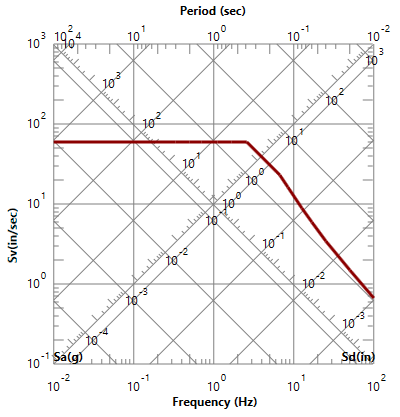
These values are as follows:
-
Frequency (f)
-
Period (T)
-
Pseudo Velocity (Sv)
-
Pseudo Acceleration (Sa)
-
Pseudo Displacement (Sd)
The relationships between these values (for the undamped case) is as follows:
-
T = 1. / f
-
Sv = Sd * 2πf = Sa / 2πf
For the tripartite plot, the frequency values are plotted along the bottom with the reciprocal period values displayed along the top. The ordinate axis plots the Sv values (labeled on the left side) and the diagonal axes plot the Sa (lower left to upper right) and Sd (upper left to lower right) values.
The spectra data itself is represented with the thick red line. Therefore, to determine the Sv, Sa or Sd value for a particular frequency or period, locate the desired period or frequency value along the abscissa axis and locate the corresponding point on the spectra line. Use this point to read off the Sv, Sa and Sd values from their respective axes. Remember, all the axes are logarithmic!
Single Spectra Plot
This plot is a Response spectra representation that is given in the building codes. The vertical axis can plot the spectra using Pseudo-Acceleration, Pseudo-Velocity, or Pseudo Displacement on a vertical or logarithmic scale. The horizontal axis plots the Period or Frequency using a Linear or Logarithmic scale.
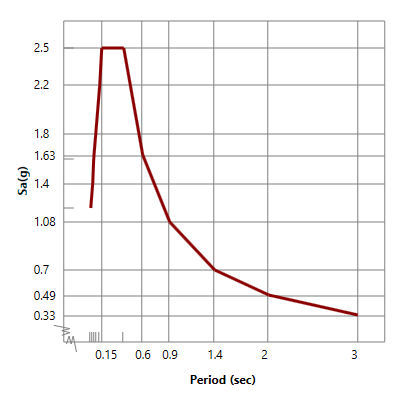
These values are as follows:
-
Frequency (f)
-
Period (T)
-
Pseudo Velocity (Sv)
-
Pseudo Acceleration (Sa)
-
Pseudo Displacement (Sd)
The relationships between these values (for the undamped case) is as follows:
-
T = 1. / f
-
Sv = Sd * 2πf = Sa / 2πf
The spectra data itself is represented with the thick red line. Therefore, to determine the Sv, Sa or Sd value for a particular frequency or period, locate the desired period or frequency value along the horizontal axis and locate the corresponding point on the spectra line. Use this point to read off the Sv, Sa and Sd values from their vertical axis.
